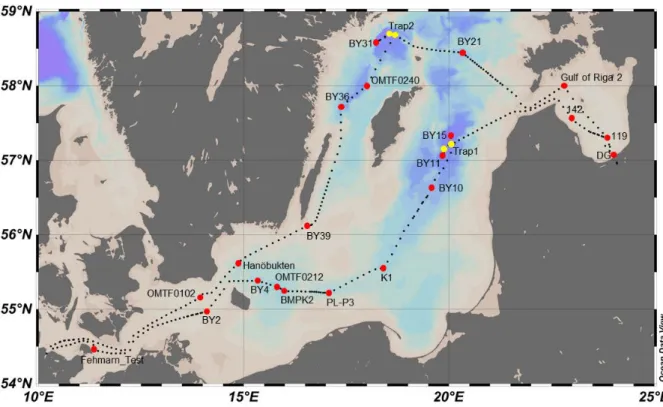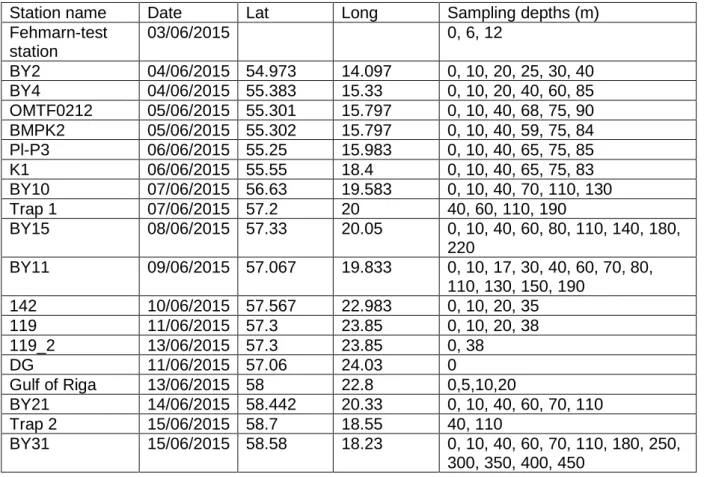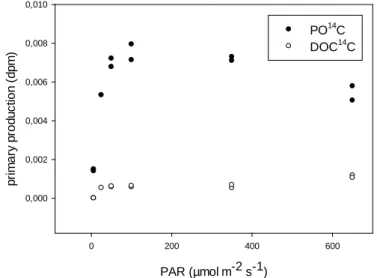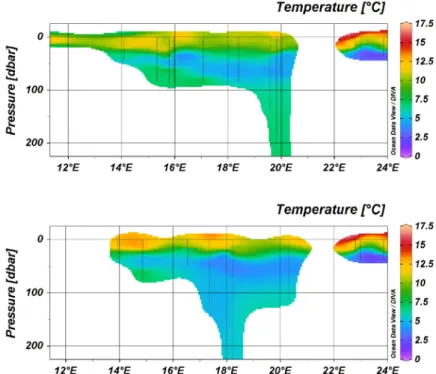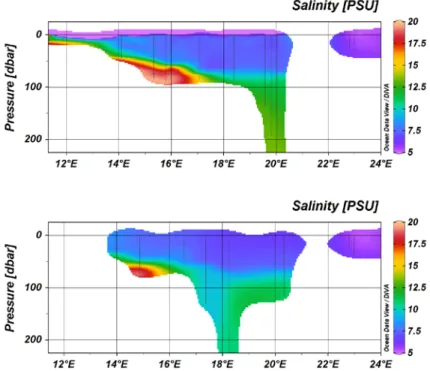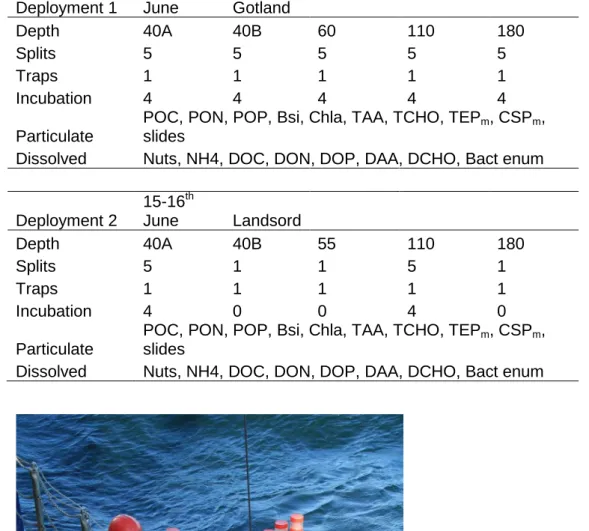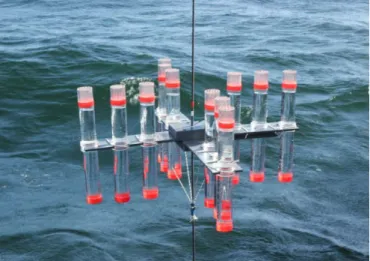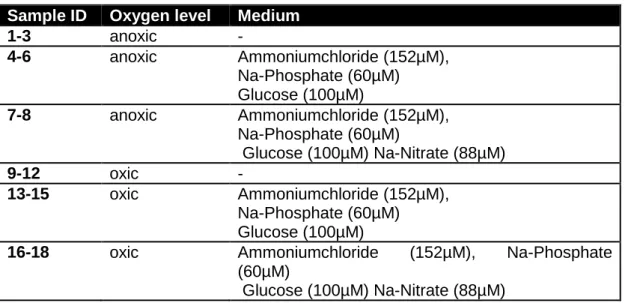Short Report Alkor Cruise AL 458
(Kiel- Riga- Kiel)
03.06.2015-19.06.2015
Chief Scientist: Prof. Dr. Anja Engel
GEOMAR Helmholtz Centre for Ocean Research Kiel Kiel, Germany
This report is based on preliminary data
1. Objectives of the cruise
The Baltic Sea is a marine ecosystem exposed to multiple stressors. Eutrophication sustains high phytoplankton productivity that fuels high oxygen demands in deeper waters. As a consequence of increasing biological oxygen consumption and high CO2 production, the expansion of hypoxic zones in the Baltic Sea has been predicted. A major process contributing to the consumption of oxygen is the microbial respiration of dissolved organic matter. Hence, the microbial production of organic matter and its subsequent remineralization are biological processes with a high potential to co-determine the direction and magnitude of future oxygen and pH changes in the Baltic Sea. However, little is known about how high nutrient loads and seawater CO2 concentration affect phytoplankton productivity. Furthermore, the relevance of organic matter composition, seawater pH and oxygen availability for carbon remineralization are largely unexplored. The proposed cruise aims at studying the production, composition and degradation of particulate and dissolved organic matter along natural gradients of inorganic nutrients, oxygen and seawater CO2 in the Baltic Sea. The cruise AL458 crossed the Southern Baltic Proper, the deep Gotland Basin and the Gulf of Riga. Sampling of depth profiles along transects was combined with onboard experiments that investigated (i) effects of oxygen concentration and organic matter composition on the bacterial turnover of dissolved organic matter (ii) effects of labile organic matter and nutrients on microbial activities under oxic and anoxic conditions (iii) degradation of halocarbons by microbial communities. The combination of field work and onboard experiments will help to better explain the environmental control of microbial processes and the contribution of microbial activity to organic carbon cycling in the Baltic Sea. In addition this cruise was part of the master program Biological Oceanography MNF-bioc.-201 (C2).
Four students participated in the cruise.
2. Cruise track
Fig. 1: Track of AL458 CTD with sampling stations (red dots) and two drifting sediment trap stations (yellow dots). First leg: Kiel-Riga, second leg: Riga-Kiel.
3. List of scientific party
Prof. Dr. ENGEL, Anja Chief scientist German
Dr. PIONTEK, Judith Scientist German
Dr. ENDRES, Sonja Scientist German
KLÜVER, Tania Technician German
ROA, Jon Technician Spanish
Dr. LE MOIGNE, Frédéric Scientist French
MASSMIG, Marie Student German
Dr. CISTERNAS-NOVOA,
Carolina Scientist Chilean
EHRLICH, Moritz Student German
WAGNER, Carola Student German
KARTHÄUSER, Clarissa Student German
STIPPKUGEL, Angela Student German
4. List of scientific equipment deployed
CTD- rosette
Surface tethered drifting sediment traps Apstein nets (20 µm, 300 µm)
Light sensor
5. Narrative of the cruise
The standard station program includes a CTD cast and water sampling with the rosette at different depth for biological and chemical measurements summarized in table, 2 Apstein net hauls (20 µm, 300 µm) and one light depth profile. All stations visited were time series
stations that have been monitored during the HELCOM program.
Wednesday, 3.6.: We left Kiel at 8:30 in stormy weather and head towards the southern Baltic Sea. After safety instructions, first test station in the Fehmarn Belt.
Thursday, 4.6.: The HELCOM station BY2 in the Arkona Sea is our first regular station. BY4 is sampled in the afternoon. Surface samples are taken to start the first experiment on halocarbon decomposition.
Friday, 5.6.: The station program is conducted at OMTF0212 and BMPK2. Net samples indicate the dominance of dinoflagellates in the size fraction <20 µm. A large number of copepods is caught in the net sample >300µm. At both stations oxygen at depth (>60m) is strongly reduced but no anoxia detected.
Saturday, 6.6.: We entered to Polish EEZ in the night and conduct the full station program at Pl-P3 and K1.
Sunday, 7.6.: In addition to the station program on BY10, water is sampled for filling of the sediment trap tubes. The traps are prepared for deployment the following day.
Monday, 8.6.: At the Gotland Deep: The drifting sediment trap was successfully deployed of.
It will collect particles over a period of 48h at the depth of 40, 60, 110 and 180m. BY15 is sampled with 9 depths in the afternoon.
Tuesday, 9.6.: Station program at BY 11 with a high resolution sampling profile (0, 10, 20, 30, 40, 60, 70, 80, 110, 130, 150 190m).
Wednesday, 10.3.: Successful recovery of the sediment trap in the morning. Afterwards, start of POM decomposition experiments with trap material. We continued our cruise track and entered the Gulf of Riga (St. 142) in the afternoon.
Thursday, 11.3.: We continued our station program at the Gulf of Riga at 119. Second halocarbon decomposition experiment with water from 119 started. Around noon a Lativian pilot came on board to navigate to Riga. At the entrance of the river Daugawa we did one CTD deployment to estimate the contribution of the river inflow on biogeochemistry of the Gulf of Riga.
Friday, 12.6.: An international workshop on marine research and management is held at the Faculty of Biology, University of Latvia, Riga.
In the afternoon a reception was given on Alkor for 28 registered Latvian scientists and two representatives of the German embassy.
Saturday, 13.6.: We left Riga in the morning and continued our field program in the Gulf of Riga at station 119. During the day the first experiment on DOM decomposition ended and samples were filtered and preserved for a variety of chemical and biological analyses. In the afternoon, the regular station program was conducted at station Gulf of Riga 2.
Sunday, 14.6.: The station program was conducted at BY21. In addition four CTD cast were conducted to collect oxic water from 40m and anoxic water from 110m depth. This water was used for preparation of the 2nd trap deployment the following days as well as to start the 2nd experiment on DOM decomposition.
Monday 15.6.: The trap was deployed in the morning at the Landsort Deep. Afterwards, BY31 was sampled with high resolution.
Tuesday, 16.6.: The trap was successfully recovered at 04:00 UTC. We then headed to stations OMTF0240 and BY36 to continue our station program. In addition to the station program samples are taken from the POM decomposition experiment.
Wednesday, 17.6.: We started in the morning with our station program for BY39 and then continued to Hanöbukten. Heading towards the western Baltic Sea, wind and waves are increasing again. In addition to the station program samples are taken from the POM decomposition experiment.
Thursday, 18.6.: At 6:00 a.m. we conducted our last station program at OMTF0102 with sampling depths. Afterwards the final samplings of the 2nd experiments on POM and DOM degradation as well as of halocarbon utilization by bacteria were finalized.
Friday, 19.6.2015: We arrived at Kiel harbor in the morning.
6. Scientific program and first results
6.1. CTD sampling(Anja Engel, Judith Piontek, Sonja Endres, Carolina Cisternas-Novoa, Frederic LeMoigne, Jon Roa, Tania Klüver, Marie Maßmig, Clarissa Karthäuser, Angela Stippkugel, Moritz Ehrlich, Carola Wagner)
A total of 24 stations were visited during the cruise AL458. Sampling of seawater was conducted with the Niskin Sampler (10L) Rosette at various depths (Table 1).
Table 1: Location and date of station visited for water sampling and trap deployment.
Station name Date Lat Long Sampling depths (m) Fehmarn-test
station
03/06/2015 0, 6, 12
BY2 04/06/2015 54.973 14.097 0, 10, 20, 25, 30, 40 BY4 04/06/2015 55.383 15.33 0, 10, 20, 40, 60, 85 OMTF0212 05/06/2015 55.301 15.797 0, 10, 40, 68, 75, 90 BMPK2 05/06/2015 55.302 15.797 0, 10, 40, 59, 75, 84 Pl-P3 06/06/2015 55.25 15.983 0, 10, 40, 65, 75, 85
K1 06/06/2015 55.55 18.4 0, 10, 40, 65, 75, 83
BY10 07/06/2015 56.63 19.583 0, 10, 40, 70, 110, 130
Trap 1 07/06/2015 57.2 20 40, 60, 110, 190
BY15 08/06/2015 57.33 20.05 0, 10, 40, 60, 80, 110, 140, 180, 220
BY11 09/06/2015 57.067 19.833 0, 10, 17, 30, 40, 60, 70, 80, 110, 130, 150, 190
142 10/06/2015 57.567 22.983 0, 10, 20, 35
119 11/06/2015 57.3 23.85 0, 10, 20, 38
119_2 13/06/2015 57.3 23.85 0, 38
DG 11/06/2015 57.06 24.03 0
Gulf of Riga 13/06/2015 58 22.8 0,5,10,20
BY21 14/06/2015 58.442 20.33 0, 10, 40, 60, 70, 110
Trap 2 15/06/2015 58.7 18.55 40, 110
BY31 15/06/2015 58.58 18.23 0, 10, 40, 60, 70, 110, 180, 250, 300, 350, 400, 450
OMTF0240 16/06/2015 58 18 0,10, 40, 70, 110, 157 BY36 16/06/2015 57.717 17.367 0, 10, 40, 60, 110, 130 BY39 17/06/2015 56.117 16.533 0, 10, 25, 40
Hanöbukten 17/06/2015 55.156 14.867 0,10,22,40,50,74 OMTF0102 18/06/2015 55.155 13.942 0, 10, 23, 36
On each station seawater samples were collected from different depths for various chemical and biological analyses (Table 2).
Table 2: Chemical and biological parameters for wich water samples were collected at different stations and depths during the cruise.
6.1.1. Nutrients, ammonium, hydrogen sulphides and salinity (Frederic Le Moigne)
A total of 76 nutrients samples were collected for silicate, phosphate, nitrate and nitrite analysis and were frozen at -20°C until further analysis in home laboratory. A total of 76 ammonium samples were analyzed onboard manually by spectrophotometry method (Shimatzu UV 1700) as described by [Koroleff, 1969]. 17 samples H2S in were preserved using a solution of zinc acetate and will be analyzed in home lab (S, Krause, B. Domeyer). In order to calibrate salinity data obtained from the CTD, salinity 32 samples were collected at different stations and depths and stored until further analysis in home laboratory.
6.1.2. Bacterial and phytoplankton abundance (Marie Maßmig)
At each station and depth samples were collected from the Niskin rosette for the analyses of bacterial and phytoplankton cell abundance via Flow Cytometry. Therefore, 4 ml sample were fixed with 200µl 25% Glutardialdehyde (GDA). These data will enable a detailed description of the vertical distribution of those organisms and the calculation of bacterial biomass production and extracellular enzyme activity per cell. Additionally a size fractionation of phytoplankton cells was performed by filtering 1.5 ml sample through a 2µm glasfiber filter and subsequent fixation with 500µl GDA. Furthermore samples for bacterial DNA (500 ml
Station NO3
NO2
PO4
SiO
NH4 DOC DON DOP
POC PON POP
CCHO AAS BSi Chl
a TEPCSP BactNo. Nano Phyt.
No.
Micro Phyt No.
DIC TA pH
Sal O2 N2O CH4
H2S Prim.
Prod. Sec.
Prod. Enz- yme Kin.
CO2
Dark fix.
Fehmarn-
test station x x x x x x x x x x x x x x x x x x x
BY2 x x x x x x x x x x x x x x x x - x x x x
BY4 x x x x x x x x x x x x x x x x x x x
OMTF0212 x x x x x x x x x x x x x x x x x x x x x
BMPK2 x x x x x x x x x x x x x x x x x x x
Pl-P3 x x x x x x x x x x x x x x x x - x x
K1 x x x x x x x x x x x x x x x x x x x x x
BY10 x x x x x x x x x x x x x x x x x x x
BY15 x x x x x x x x x x x x x x x x x x x x x
BY11 x x x x x x x x x x x x x x x x - x x x x
142 x x x x x x x x x x x x x x x x - x x x x
119 x x x x x x x x x x x x x x x x - x x x x
DG x x x x x x x x x x x x x x x x - x x
Gulf Riga 2 x x x x x x x x x x x x x x x x - x x
BY21 x x x x x x x x x x x x x x x x x x x x x
BY31 x x x x x x x x x x x x x x x x x x x x x
OMTF0240 x x x x x x x x x x x x x x x x x x x
BY36 x x x x x x x x x x x x x x x x x x x
BY39 x x x x x x x x x x x x x x x x - x x x x
Hanöbukten x x x x x x x x x x x x x x x x - x x
OMTF0102 x x x x x x x x x x x x x x x x - x x x x
seawater filtered on a 0,2µm Durapore membrane filter) were taken from three depths per station. For analysis of Zoo- and Phytoplankton abundances water samples from the first three depth as well as net samples from a 300µm and 20µm nets were preserved with Lugol.
6.1.3. Particulate matter: POC, PN, POP, Chl a, BSi (Carolina Cisternas-Novoa)
The composition of particulate organic matter that is formed in the photic zone and is transported below the mixed layer depend not just on their source in the surface waters, but also on alteration, supplementation, and selective removal that occurs during vertical transit.
Organic matter composition is a major factor in determining its susceptibility to microbial degradation and remineralization. Recent studies show that in suboxic zones, the lability of a compound is the most significant parameter determining its degradation rate (Pantoja et al., 2009). The Baltic Sea is a unique environment with strong natural north-south gradients of nutrients and O2 concentrations. The presence of this natural variability provides an excellent opportunity to study the effect of multiple stressors in organic matter cycling. In terms of particulate organic matter, the goal of this cruise was to study how high nutrient
concentrations and particularly low O2 concentration will affect the distribution, relative composition and degradation rates of organic compounds. During the cruise we collect deep profiles samples from 22 stations, with different levels of inorganic nutrients and O2.
Seawater was collected by CTD/rosette sampler from 1 to 12 depths depending on station depth. Subsamples were filtered on board for analysis of each 112 samples for particulate organic carbon and nitrogen (POC/PN), particulate organic phosphorous (POP), biogenic silica (BSi) and Chlorophyll-a (Chl-a).
6.1.4. Dissolved organic matter (DOC, DON, DOP) (Anja Engel, Jon Roa)
Little is known about how DOM cycling will become affected by changing ecosystem, yet DOM cycling plays a major role in O2 consumption, CO2 release and nutrient regeneration. In particular, the relationship between DOM composition and its bacterial remineralization that, in turn, releases CO2 and consumes oxygen is largely unexplored but of utmost importance to evaluate carbon budgets in coastal marine systems under global change. Results of this cruise shall help to better estimate carbon and nutrient cycling and hence ecosystem health and productivity in coastal and marginal seas. To investigate the elemental stoichiometry of DOM, a total of 112 samples for each dissolved organic carbon (DOC), nitrogen (DON) and phosphorous (DOP) were collected at each station and depth. DOC and DON will be analyzed using the high-temperature combustion method (TOC-VCSH, Shimadzu) (Qian and Mopper, 1996). Dissolved organic phosphorous (DOP) will be oxidized with peroxodisulfate solution and analyzed spectrophotometrically as phosphate (Grasshoff et al., 1983).
6.1.5. Carbohydrates and amino acids (Anja Engel, Jon Roa)
Carbohydrates and amino acids proved valuable to trace biological production and decomposition processes in response to e.g. nutrient input, oxygen availability and temperature. Highly sensitive IC- and HPLC-techniques will be applied to analyze concentrations and compositions of amino acids (AA) and carbohydrates (CHO) in DOM.
Aside neutral sugars and amino sugars, a novel protocol for carbohydrate analysis will allow for the detection of the acidic sugars gluconic acid, glucuronic acid and glacturonic acid (Engel and Händel, 2011). Amino acids and carbohydrates are rather indicative of recent
biological production, while Colorimetric DOM (CDOM) that enter the Baltic Sea through river discharge seems to accumulate over longer time scale and displays a more conservative behavior (Coble, 2007).
During AL458, at total of 112 of each dissolved CCHO, total CCHO, dissolved AA and total AA were collected.
6.1.6. Marine gel particles (TEP, CSP) (Anja Engel)
Gel particles represent important microbial habitats and comprise significant fractions of extracellular carbon and nitrogen. Transparent exopolymer particles (TEP) and Coomassie- stainable particles (CSP) will be determined colorimetrically and microscopically using semi- automated image analysis (Engel, 2009). In the Baltic Sea, TEP play a pivotal role in particle aggregation processes during summer (Engel et al., 1999). Sofar there is only little information on the abundance in deeper parts of the Baltic Sea and on the role of oxygen for gel particle cycling. During this cruise a total of 112 samples were collected on all stations and depth for each colorimetric determination of TEP and CSP, respectively as well as for microscopic analysis of TEP and CSP size distributions.
6.1.7. Primary production (Anja Engel, Tania Klüver)
Primary production (PP) was determined by the uptake of 14C-labelled sodium bicarbonate and subsequent liquid scintillation counting according to Steemann Nielsen (1952) and Gargas (1975). Primary production was measured in samples collected from the surface (1m) at exposed to different light intensities (6-650 µmol m-2 s-1) for 16-24h. PO14C production was determined on Nuclepore filters of 0.4 μm pore size, while DO14C production was determined from filtrates after acidification. A total of 11 stations was sampled for deriving P vs. I curves.
PAR (µmol m-2 s-1)
0 200 400 600
primary production (dpm)
0,000 0,002 0,004 0,006 0,008 0,010
PO14C DOC14C
Figure 2: Photosynthesis versus irradiance curve for primary particulate and dissolved organic carbon production, exemplified for station BY21.
6.1.8. Bacterial activities (Judith Piontek)
Bacterial biomass production and rates of major hydrolytic extracellular enzymes were determined at all stations to investigate heterotrophic bacterial activity. Biomass production
was derived from the uptake of 3H-labelled leucine at saturating concentration of 20 nmol L-1 during 1-3 hours of incubation. In addition to the standard protocol according to Smith and Azam (1992), incubations in gas-tight vials were accomplished for selected samples of anoxic and suboxic deep water. Fluorogenic substrate analogues were added to whole seawater samples to estimate the activity of extracellular beta-glucosidase, leucine-
aminopeptidase and phosphatase (Hoppe, 1983). Enzyme kinetics were derived from rates at eight different substrate concentrations ranging from 1 to 200 µmol L-1. For selected samples both oxic and anoxic incubation was carried out to test for potential effects of oxygen availability.
For selected samples (13 stations, 2-3 depths per station) dark CO2 fixation was analyzed to assess the potential for chemolithoautotrophic production. For this purpose, 60 mL of sample were spiked with 25 µL of a 14C-bicarbonate solution and incubated for 24 hours in the dark close to in situ temperature. After incubation, cells were collected on 0.2 µm-polycarbonate filters and analyzed by liquid scintillation counting.
6.2. CTD depth profiles
(Anja Engel, Carola Wagner)CTD cast were conducted on each station and revealed thermal stratification of the upper water column of the Baltic sea, with a thermocline at about 25m, and increasing surface temperatures in the Gulf of Riga. At depth, inflow of warmer and more saline North Sea water masses were detected in the Gotland Deep, but not in the Landsort Deep. In the deeper basins, a strong halocline was observed at 50 – 70m depth.
Figure 3: Temperature distribution along leg 1 (upper panel) and leg 2( lower panel).
Figure 4:Salinity distribution along leg 1 (upper panel) and leg 2( lower panel).
6.3.
Surface drifting sediment traps
(Frederic Le Moigne, Jon Roa, Carolina Cisternas-Novoa, Anja Engel) Scientific motivation
Climate models predict a decline in dissolved oxygen concentration and a consequent expansion of the Oxygen Minimum Zones (OMZ) in the future ocean. One crucial biogeochemical mechanism is the process by which of carbon is transferred into the deep ocean, the biological carbon pump (BCP). There is currently little consensus on the fate of sinking OM and the efficiency of the BCP in OMZ areas. Previous particles flux studies have shown that in, the BCP is more efficient in suboxic zones relative to surrounding well oxygenated waters. However, incubations performed on sinking material collected in oxic and suboxic areas have observed similar remineralisation rate in both conditions suggesting that suboxic conditions do not enhance the transfer of sinking OM through the mesopelagic zone. During this cruise, we wanted to assess how different oxygen conditions and surface productivity impact C:N:P remineralization rate of sinking particles
Therefore, two free drifting traps deployments were performed in both oxygen deficient Gotland (deployment 1) and Landsort (deployment 2) deeps for a period of 48 and 24 hours respectively. Deployments dates, traps depths and splits for subsequent analysis/experiments are given in Table 3.
Table 3: Trap depths and parameters analysed.
Deployment 1
8-10th
June Gotland
Depth 40A 40B 60 110 180
Splits 5 5 5 5 5
Traps 1 1 1 1 1
Incubation 4 4 4 4 4
Particulate
POC, PON, POP, Bsi, Chla, TAA, TCHO, TEPm, CSPm, slides
Dissolved Nuts, NH4, DOC, DON, DOP, DAA, DCHO, Bact enum
Deployment 2
15-16th
June Landsord
Depth 40A 40B 55 110 180
Splits 5 1 1 5 1
Traps 1 1 1 1 1
Incubation 4 0 0 4 0
Particulate
POC, PON, POP, Bsi, Chla, TAA, TCHO, TEPm, CSPm, slides
Dissolved Nuts, NH4, DOC, DON, DOP, DAA, DCHO, Bact enum
Figure 5: Preparation of the drifting sediment trap with a total of 12 collection tubes per depth during AL 458.
Figure 6: Each cross is lowered separately to the water column during deployment of the surface tethered drifting sediment trap.
Drifting of the traps was monitored over the duration of the deployment by use of GPS of an IRIDIUM sensor (Figure 7a, b). Average drift during both deployments was about 12knots.
Figure 7a, b: Positions of the trap during the drift at the Gotland Deep (left) and Landsort Deep (right) area.
6.3. Decomposition of DOM (Marie Maßmig)
The increasing emission of carbon dioxide can be directly related to the enhanced deoxygenation of our ocean. This increase in oxygen minimum zones is influencing chemical as well as biological processes and has to be taken into account for future predictions regarding climate change scenarios. One important factor is the role of bacteria. They take part in the turnover of organic matter and the formation as well as the dissolution of particles.
Thus they affect the export of carbon, which is important for counteracting the accumulation of carbon dioxide in the atmosphere. To investigate the impact of oxygen deficiency on the bacterial turnover of organic matter I conducted two experiments during the cruise. For both experiments the hypotheses were:
H1: The bacterial growth and the turnover of organic matter will be reduced under anoxic conditions compared to oxic conditions.
H2: Oxygen sensitivity of bacterial growth is co-determined by substrate availability and composition.
My first experiment took place from the 8th of June until the 13th of June at the Helcome station BY 15 (57°2030N; 20°3015E) in the Gotland Deep. I performed my incubation with oxygen depleted (9.46µmol O2/l), prefiltered (100µm) water out of 110m depth.
I had 6 treatments with three replicates each (see tab. 1): an anoxic and an oxic control treatment without added nutrients, an oxic and an anoxic treatment with glucose (100µM), ammonium (152µM) and phosphate (60µM) as well as an oxic and an anoxic treatment with glucose (100µM), ammonium (152µM), phosphate (60µM) and nitrate (88µM).
The bottles for the anoxic treatment were closed with a gas tight cap and a septum, whereas the ones for the oxic treatment were closed with permeable parafilm. To create anoxic conditions after filtering, the gas tight bottles were bubbled for four hours with a gas mixture containing 0.1283% CO2 in pure nitrogen. To have the same conditions, also the oxic treatments were bubbled with synthetic air. After the bubbling the incubations were kept in the dark at 10°C on a shaker.
Table 4: Incubation from 8/6/2015 until 13/6/2015 with water from the Helcome station BY15 Sample ID Oxygen level Medium
1-3 anoxic -
4-6 anoxic Ammoniumchloride (152µM), Na-Phosphate (60µM) Glucose (100µM)
7-8 anoxic Ammoniumchloride (152µM), Na-Phosphate (60µM)
Glucose (100µM) Na-Nitrate (88µM)
9-12 oxic -
13-15 oxic Ammoniumchloride (152µM), Na-Phosphate (60µM) Glucose (100µM)
16-18 oxic Ammoniumchloride (152µM), Na-Phosphate (60µM)
Glucose (100µM) Na-Nitrate (88µM)
The second experimental set up was similar to the first one, but focused on the availability of glucose and oxygen ignoring the influence of nutrients (see tab. 2). The water was sampled at the HELCOM station BY21 (58°26530N; 20°19938E) at 110m depth where the oxygen concentration was 1.68 µM. The 14th of June and the experiment ended the 18th of June.
Table 5: Incubation from 14/6/2015 until 18/6/2015 with water from the HELCOM station BY21
Sample ID Oxygen level Medium
1-3 anoxic -
4-6 anoxic Glucose (100µM)
7-8 oxic -
9-12 oxic Glucose (100µM)
In both experiments cell abundance and oxygen concentrations as well as enzyme rates were measured daily to control the treatments as well as analyze the bacterial enzyme activity and growth.
At the beginning and the end several additional parameters were sampled. First the proportions of dissolved and particulate organic carbon as well as transparent extrapolymeric particles will present the turnover of organic carbon by the microorganisms. Next the analysis of nutrients can represent changes in the nitrogen composition by denitrification under anoxic conditions. The determination of bacterial biomass production helps to define bacterial growth and bacterial DNA will specify the represented species. Finally the composition aminoacids and sugars as well as extracellular enzyme activity, will show detailed bacterial enzymatic activity.
6.4. Decomposition of POM (Frederic Le Moigne)
Two distinct incubations were performed using material from the two trap deployments (1 and 2) described above. After splitting and zooplankton picking (through 200µm mesh), sediment trap material was incubated in 1.2L gas tight bottles fixed on a rotating plankton wheel (2 rpm) at constant temperature (10°C). Oxygen concentrations in some of the bottles were manipulated and lowered using a gas mix of 0.1283% CO2 in pure N2. Oxygen treatments, time steps for both incubations are summarized in Table 4. Parameters listed in Table 1 were sampled only for 17th June and 18th June time steps. Only POC, PON, POP, Bsi, Chla, Nuts, NH4, DOC, DON, DOP and Bact enum were sampled for the 10th, 13th, 15th and 16th of June time steps.
Table 6: Incubations treatments, dates and O2 concentrations.
ID Depth O2 treat. set up sampling O2 concentrations at start (mg l-1)
T1 F1 40A local 10th
June 13th June 12.71
T1 F2 40A local 10th
June 17th June 12.78 T1 F3 40A lowered 10th
June 13th June 0.45
T1 F4 40A lowered 10th
June 17th June 0.70
T1 F5 40B local 10th
June 13th June 13.16
T1 F6 40B local 10th
June 15th June 10.06
T1 F7 40B local 10th
June 16th June 10.88
T1 F8 40B local 10th
June 17th June 10.86
T1 F9 60 local 10th
June 13th June 9.00
T1 F10 60 local 10th
June 15th June 11.43
T1 F11 60 local 10th
June 16th June 11.48
T1 F12 60 local 10th
June 17th June 12.03
T1 F13 110 lowered 10th
June 13th June 0.50
T1 F14 110 lowered 10th
June 15th June 0.63
T1 F15 110 lowered 10th
June 16th June 1.23
T1 F16 110 lowered 10th
June 17th June 0.94
T1 F17 180 local 10th
June 13th June 4.90
T1 F18 180 local 10th
June 15th June 5.70
T1 F19 180 local 10th
June 16th June 5.42
T1 F20 180 local 10th
June 17th June 4.77
T2 F1 40A local 16th
June 18th June 12.00
T2 F3 40A local 16th
June 18th June 11.50 T2 F5 40A lowered 16th
June 18th June 0.19
T2 F9 40A lowered 16th
June 18th June 0.19
T2 F13 110 lowered 16th
June 18th June 0.16
T2 F17 110 lowered 16th
June 18th June 0.85
Particles were incubated for several days and the evolution of various remineralisation parameters as well as the stoichiometry (C:N:P) of the particulate organic, the dissolved organic and the dissolved inorganic pools (see parameters listed in Table 3) will be monitored. For instance, the evolution of nitrate, phosphate will provide results of net C:N:P remineralisation rate. Besides, degradation index (amino-acids and sugards) will be monitored in order to quantify the rate at which N rich OM is consumed relative to C rich OM.
6.6. Oxygen, trace gases and carbonate chemistry (Sonja Endres)
Water column (CTD) samples were taken for oxygen (O2), nitrous oxide (N2O), methane (CH4), dissolved inorganic carbon (DIC) concentrations, as well as total alkalinity (TA) and pH.
Samples for oxygen determination were taken from every station for calibration of the oxygen sensor of the CTD. Oxygen concentration was determined using triplicate optode
measurements. Additionally, oxygen concentrations of selected depth (surface, minimum, maximum) were determined by Winkler titration. Water samples for the measurements of N2O and CH4 concentrations from 13 selected CTD stations in the Baltic proper were taken, preserved with HgCl2 and stored at room temperature. Samples will be analyzed by gas chromatography in the lab of Hermann Bange at GEOMAR. In order to determine the carbonate chemistry, water samples for total alkalinity were taken of all CTD stations and preserved for future analysis at GEOMAR. pH was measured directly on board by electrode.
Determined pH values will be corrected to in-situ temperature. Additionally, water samples of selected stations and depth were preserved with HgCl2 for analysis of DIC concentration in the lab of Arne Körzinger at GEOMAR.
Incubation experiments
Surface water samples from station BY4 and 119 were collected for incubation experiments to study microbial halocarbon degradation. The unfiltered seawater was amended with 13C- labelled bromoform (~70pM) and incubated at 20°C in the dark. Samples were collected regularly for bacterial abundance, bacterial production, bromocarbons and dissolved organic matter concentrations. Control incubations included seawater only and artificial seawater or ultrapure water with 13C-labelled substrate.
Figure 8: Setup of the 2nd halocarbon degradation experiment on board.
Additionally, seawater samples were taken at four selected stations and preserved with hydrochloric acid for further determination of halocarbon concentrations over depth (lab of B.
Quack, GEOMAR) and comparison to bacterial abundance and activity.
6.7. Student report AL458 cruise from the 3rd until the 19th of June 2015 (Moritz Ehrlich, Angela Stippkugel, Clarissa Karthäuser and Carola Wagner)
Background and preparation: As part of our Msc. program Biological Oceanography and the practical MNF- bioc 201, we got the opportunity to participate in the above mentioned cruise. To prepare for the cruise, we were asked to gather and plot data from the HELCOM data set for all stations that were to be sampled on the cruise. We prepared time series and depth profiles of various parameters in R such as oxygen levels, salinity and diverse nutrients. The data was formatted to suit the planned scientific program and therefore limited to daytime data points from May to July during the last 50 years. We presented and
discussed these plots every evening in the group meeting to give an overview for the upcoming stations.
Practical training: In order to teach us as many practical methods as possible, we rotated between four different work stations after every 6th CTD station, assisting the scientific professionals with their daily measurements. The work stations included filtration methods for particulate organic matter (POC, POP, BSi and Chl a) as well as TEP and CSP. Further methods included oxygen determination according to Winkler and with optodes as well as photometric analysis of ammonia and hydrogen sulfides. Daily light measurements were also conducted.
Riga: During our stay in Riga we attended the joint workshop with Latvian aquatic ecologists and welcomed them aboard the Alkor for a buffet in the evening. We showed them around the ship and learned about the differences and similarities of our institutes and cultures.
Additional skills: Apart from the regular station sampling, we helped preparing additional experiments conducted by the participating scientists such as deploying sediment traps and analyzing trap materials. The boat crew of the Alkor vessel also included us in their daily routines such as CTD handling and crane operation.
Figure 9: Students of the Masterprogram Biological Oceanography (MNF-bioc. 201) during the Alkor Cruise. From left to right: Carola Wagner, Moritz Ehrlich, Angela Stippkugel, Clarissa Karthäuser.
References
Cline, J. D., and F. A. Richards (1972), Limnology and Oceanography, 14, 454.
Koroleff, F. (1969), Direct determination of ammonia in natural water as indophenol blue, Information on Techniques and Methods for the Seawater Analysis.
Coble, P.G. (2007). Marine Optical Biogeochemistry – The Chemistry of Ocean Color. Chem. Rev. 107(2): 402- 418.
Engel, A.: Determination of Marine Gel Particles, in: Practical Guidelines for the Analysis of Seawater, 1st Edn., edited by: Wurl, O., CRC Press, Boca Raton, FL, 125–141, 2009.
Engel, A., Händel, N. (2011). A novel protocol for determining the concentration and composition of sugars in particulate and in high molecular weight dissolved organic matter (HMW-DOM) in seawater. Marine Chemistry 127, 180-191.
Gargas, E.: A Manual for Phytoplankton Primary Production Studies in the Baltic, The Baltic Marine Biologists, 2, p. 88, 1975.
Grasshoff, K., Ehrhardt, M., and Kremling, K.: Determination ofnutrients, 2nd Edn., Verlag Chemie, Weinheim, 1983.
Hansen, H. P. and Koroleff, F. (1999). Determination of nutrients, in: Methods of Seawater Analysis, edited by:
Grasshoff, K. K. K. and Ehrhardt, M., John Wiley, Hoboken, NJ, 159–22.
Hoppe, H.-G. (1983). Significance of exoenzymatic activities in the ecology of brackish water – Measurements by means of methylumbelliferyl-Substrates, Mar. Ecol.-Prog. Ser., 11, 299–308.
Pantoja, S. et al., 2009. Microbial degradation rates of small peptides and amino acids in the oxygen minimum zone of Chilean coastal waters. Deep Sea Research Part II: Topical Studies in Oceanography, 56(16): 1055- 1062.
Smith, D. C. and Azam, F. (1992). A simple, economical method for measuring bacterial protein synthesis rates in seawater using 3H-leucine. Mar. Microb. Food Webs, 6, 107–114, 1992.
Steemann Nielsen, E.: The Use of Radioactive Carbon (14C) for Measuring Primary Production in the Sea, J.
Cons. Perm. Int. Explor. Mer., 18, 117–140, 1952.
Qian, J. and Mopper, K. (1996). Automated high-performance, high temperature combustion total organic carbon analyzer, Anal. Chem., 68, 3090–3097.
